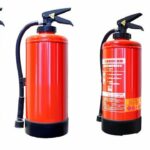Have you ever seen floor indicators in the form of cones and stripes as shown in the picture below near the escalator or staircase at shopping malls? They are nothing but tactical indicators which means an indicator that helps visually impaired people to get aware of any approaching hazard or danger. It also helps pedestrians as it provides safety precautions for them as well.
It is an industry practice, which every owner needs to take care, particularly when building a commercial or a public places. They have raised stud or bar patterns which can be felt through feet or even with a white cane. We can find them in different colors at different places as they are designed in such a way that it is contrasted with the ground surface so that pedestrians can easily detect the modules visually for safer movement.
They are very useful as it provides dignified, prudent, and independent access to and within the community. You can see them at pedestrian crossings, intersection curb ramps, lifts, stairs, escalators, and ramps. Also to alert the pedestrians about platform edges at train stations or bus stations.

Warning Tactile Indicators
Whether you say ‘Warning Tactile Indicators ‘or ‘Hazard Tactile’ or ‘Decision Tactile’ it’s one and the same. They are raised grid patterns of studs or dots to the surface of walking as we can see in the picture given below. As the name suggests it’s main function is to warn visually impaired pedestrians about any nearby danger. But it won’t tell us what the danger or hazard is. It is just used to alert the visually impaired pedestrians about the upcoming probability of danger and indicating to them to think about the probable nature of hazard before moving further.
In Warning Tactile, there are different varieties of tactiles such as Blister ,Offset Blister and Lozenge.
-
Blister Tactile-
It is to warn the visually impaired people and help them to differentiate between footway ends and the carriageway begins. The surface of this kind of tactile has rows of flat-topped blisters in square pattern.
-
Offset Blister Tactile-
It is to warn vision-challenged people about the edge of all off-street railway platforms. It consists of flat-topped domes, having a space of 66.5 mm from the centre of one dome to the other one. Another name of this tactile is “platform edge warning surface”.
-
Lozenge Tactile –
It is to warn visually impaired people about the edge of an on-street light rapid transit (LRT) platform. And that’s why it is also called the platform edge (on-street) warning surface.

Directional Tactile Indicators
Again as the name suggests, Directional Tactile Indicators give directional guidance in open spaces and designate the pathway to be taken to avoid any hazards further and to have a gain over the crossing point, point of entry to any public facility like public toilet and public transport availability points. There are raised bars installed to the surface to give direction for travel and also lead the walker to the intended pathway free from any kind of obstacles.
These tactiles are also available in different colors, slip-resistant, easy to install and individual tiles installed together.
Different varieties of Directional Tactile Indicators are:-
-
Linear Directional Indicators –
It is used to guide pedestrians about obstacles, find a particular location for visually challenged people.
-
Corduroy Tactile –
It is used to warn the visually impaired people regarding presence of some specific hazards such as steps,approach to LRT platform or level crossings. It gives us a message that “hazard, proceed with caution”.
-
Cycle Way Tactile –
The tactile surface is used with a segregated shared cycle track and footpath to advise the visually challenged on the right side to enter.
The image below clearly shows the types of Directional Tactile Indicators.

Also Read:
- Top 5 best Fire Extinguisher for Car in USA
- Top 5 Best Jump Starters for Cars
- 18 Best Car Gadgets and Accessories for Road Trips
What is the Difference between Warning & Directional Tactile Indicators?
After knowing the basic meaning of Warning and Directional Indicators, we can easily come to know the major difference between both. The main difference between these two Indicators is that warning indicators give us warning about the upcoming danger but don’t give a clue regarding the danger, whereas Directional Indicators give us a direct directional pathway to avoid any kind of danger for visually impaired people or normal pedestrians. Warning Indicators are like stop signs and Directional Indicators are showing us a safer pathway to be followed.
Applications of Tactile Indicators
The main purpose of Tactile Indicators is to give safe directions to pedestrians, especially who are blind or who are visually impaired and inform them about the hazards. As discussed before, Tactile Indicators are used at commercial places and places where public gatherings are more such as shopping malls, ferry docks, railway stations,bus stations,tram stop areas,etc. They are used in places as mentioned below -:
- Intersection kerb ramps
- Ramps
- Entry and exit points
- Elevators
- Escalators
- Pedestrian crossings
- Stairs
- Public transport facilities
Some public places where Tactile Indicators are must – :
1) Hospitality Venues – Restaurants and bars usually have elevation and lighting styles. Therefore having tactile indicators is necessary.
2) Schools and Hospitals – Indicators at entry and exit points as there are high chances of slips in these sensitive areas.
3) Retail Stores – Tactile Indicators near elevators to avoid any danger and have a safe shopping experience.
4) Recreational facilities – Required near steps and other sporting or exhibition areas for a safe environment.
5) Parks, Pedestrian crossings and Public offices– for the safety of the public and for prevention of accidents.
Therefore, tactile indicators are a very important tool for the safety and security of visually impaired people as well as for normal pedestrians in public places to protect them from possible accidents or hazards. They are found in almost every place where there is huge public traffic or possibility of slips and fall over.
FAQ’s
Q.1) What are Tactile Indicators in simple language?
Ans. Tactile Indicators are a type of indicator which are like raised cones or bars installed on floor surface to assist the visually impaired people and awaken them regarding the hazards near them.
Q.2) Is it necessary to install Tactile Ground Surface Indicators ?
Ans. Yes, it is necessary for the builders to install tactile indicators at commercial places or at public places to assist the visually impaired people in some situations such as stairs and stair landings, carriageways without kerbs,water bodies,overhead hazards,etc.
Q.3) Are Warning Tactile Indicators and Directional Tactile Indicators the same?
Ans. No, Warning Tactile Indicators and Directional Tactile Indicators are different as Warning Tactile Indicators are type of indicator that warns visually impaired people or pedestrians regarding the upcoming hazards but do not tell us about the hazard. And Directional Tactile Indicators directs the vision- impaired people to follow the particular path to avoid any kind of accidents.
Q.4) How are Tactile Indicators designed and made available in the market?
Ans. They are designed using the latest and modern technology so that it doesn’t collide with vehicles and prevents trip hazards. They are available in different types that you can select from based on your needs and requirements of an area such as peel and stick,single studs, and tactile plates.
Q.5) Where did tactile indicators originate?
Ans. Nowadays, we can see tactile indicators all over the world but it was first installed in Okayama city in Japan in 1965. It was invented by Seiichi Miyake.








